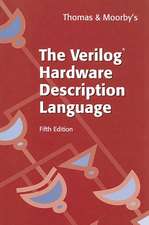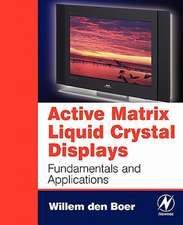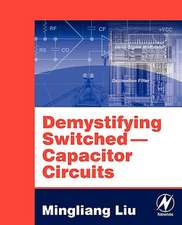SystemVerilog for Verification: A Guide to Learning the Testbench Language Features
Autor Chris Spearen Limba Engleză Paperback – 5 noi 2010
This second edition contains a new chapter that covers programs and interfaces as well as chapters with updated information on directed testbench and OOP, layered, and random testbench for an ATM switch. This edition also includes a new chapter that covers “Interfacing to C” and many new and improved examples and explanations.
For hardware engineers, the book has several chapters with detailed explanations of Object Oriented Programming based on years of teaching OOP to hundreds of students. For software engineers, there is a wealth of information on testbenches, multithreaded code, and interfacing to hardware designs. The reader only needs to know the Verilog 1995 standard.
"The complete book that covers verification concepts and use of system verilog in Verification, taking your from an easy start to advanced concepts with ease.
Paul D. Franzon, Alumni Distinguished Professor of ECE, North Carolina State University"
Preț: 789.20 lei
Preț vechi: 962.44 lei
-18% Nou
Puncte Express: 1184
Preț estimativ în valută:
151.03€ • 163.100$ • 126.87£
151.03€ • 163.100$ • 126.87£
Carte tipărită la comandă
Livrare economică 22 aprilie-06 mai
Preluare comenzi: 021 569.72.76
Specificații
ISBN-13: 9781441945617
ISBN-10: 144194561X
Pagini: 468
Ilustrații: XXXVI, 429 p. 5 illus.
Dimensiuni: 155 x 235 x 25 mm
Greutate: 0.65 kg
Ediția:Softcover reprint of the original 2nd ed. 2008
Editura: Springer Us
Colecția Springer
Locul publicării:New York, NY, United States
ISBN-10: 144194561X
Pagini: 468
Ilustrații: XXXVI, 429 p. 5 illus.
Dimensiuni: 155 x 235 x 25 mm
Greutate: 0.65 kg
Ediția:Softcover reprint of the original 2nd ed. 2008
Editura: Springer Us
Colecția Springer
Locul publicării:New York, NY, United States
Public țintă
Professional/practitionerCuprins
1. Verification Guidelines.- 1.1 The Verification Process.- 1.2 The Verification Methodology Manual.- 1.3 Basic Testbench Functionality.- 1.4 Directed Testing.- 1.5 Methodology Basics.- 1.6 Constrained-Random Stimulus.- 1.7 What Should You Randomize?.- 1.8 Functional Coverage.- 1.9 Testbench Components.- 1.10 Layered Testbench.- 1.11 Building a Layered Testbench.- 1.12 Simulation Environment Phases.- 1.13 Maximum Code Reuse.- 1.14 Testbench Performance.- 1.15 Conclusion.- 2. Data Types.- 2.1 Built-in Data Types.- 2.2 Fixed-Size Arrays.- 2.3 Dynamic Arrays.- 2.4 Queues.- 2.5 Associative Arrays.- 2.6 Linked Lists.- 2.7 Array Methods.- 2.8 Choosing a Storage Type.- 2.9 Creating New Types with typedef.- 2.10 Creating User-Defined Structures.- 2.11 Type conversion.- 2.12 Enumerated Types.- 2.13 Constants.- 2.14 Strings.- 2.15 Expression Width.- 2.16 Conclusion.- 3. Procedural Statements and Routines.- 3.1 Procedural Statements.- 3.2 Tasks, Functions, and Void Functions.- 3.3 Task and Function Overview.- 3.4 Routine Arguments.- 3.5 Returning from a Routine.- 3.6 Local Data Storage.- 3.7 Time Values.- 3.8 Conclusion.- 4. Connecting The Testbench and Design.- 4.1 Separating the Testbench and Design.- 4.2 The Interface Construct.- 4.3 Stimulus Timing.- 4.4 Interface Driving and Sampling.- 4.5 Connecting It All Together.- 4.6 Top-Level Scope.- 4.7 Program — Module Interactions.- 4.8 SystemVerilog Assertions.- 4.9 The Four-Port ATM Router.- 4.10 The ref Port Direction.- 4.11 The End of Simulation.- 4.12 Directed Test for the LC3 Fetch Block.- 4.13 Conclusion.- 5. Basic Oop.- 5.1 Introduction.- 5.2 Think of Nouns, not Verbs.- 5.3 Your First Class.- 5.4 Where to Define a Class.- 5.5 OOP Terminology.- 5.6 Creating New Objects.- 5.7 Object Deallocation.- 5.8 Using Objects.- 5.9Static Variables vs. Global Variables.- 5.10 Class Methods.- 5.11 Defining Methods Outside of the Class.- 5.12 Scoping Rules.- 5.13 Using One Class Inside Another.- 5.14 Understanding Dynamic Objects.- 5.15 Copying Objects.- 5.16 Public vs. Local.- 5.17 Straying Off Course.- 5.18 Building a Testbench.- 5.19 Conclusion.- 6. Randomization.- 6.1 Introduction.- 6.2 What to Randomize.- 6.3 Randomization in SystemVerilog.- 6.4 Constraint Details.- 6.5 Solution Probabilities.- 6.6 Controlling Multiple Constraint Blocks.- 6.7 Valid Constraints.- 6.8 In-line Constraints.- 6.9 The pre_randomize and post_randomize Functions.- 6.10 Random Number Functions.- 6.11 Constraints Tips and Techniques.- 6.12 Common Randomization Problems.- 6.13 Iterative and Array Constraints.- 6.14 Atomic Stimulus Generation vs. Scenario Generation.- 6.15 Random Control.- 6.16 Random Number Generators.- 6.17 Random Device Configuration.- 6.18 Conclusion.- 7. Threads and Interprocess Communication.- 7.1 Working with Threads.- 7.2 Disabling Threads.- 7.3 Interprocess Communication.- 7.4 Events.- 7.5 Semaphores.- 7.6 Mailboxes.- 7..- 7.7 Building a Testbench with Threads and IPC.- 7.8 Conclusion.- 8. Advanced Oop and Testbench Guidelines.- 8.1 Introduction to Inheritance.- 8.2 Blueprint Pattern.- 8.3 Downcasting and Virtual Methods.- 8.4 Composition, Inheritance, and Alternatives.- 8.5 Copying an Object.- 8.6 Abstract Classes and Pure Virtual Methods.- 8.7 Callbacks.- 8.8 Parameterized Classes.- 8.9 Conclusion.- 9. Functional Coverage.- 9.1 Coverage Types.- 9.2 Functional Coverage Strategies.- 9.3 Simple Functional Coverage Example.- 9.4 Anatomy of a Cover Group.- 9.5 Triggering a Cover Group.- 9.6 Data Sampling.- 9.7 Cross Coverage.- 9.8 Generic Cover Groups.- 9.9 Coverage Options.- 9.10 Analyzing CoverageData.- 9.11 Measuring Coverage Statistics During Simulation.- 9.12 Conclusion.- 10. Advanced Interfaces.- 10.1 Virtual Interfaces with the ATM Router.- 10.2 Connecting to Multiple Design Configurations.- 10.3 Procedural Code in an Interface.- 10.4 Conclusion.- 11. A Complete Systemverilog Testbench.- 11.1 Design Blocks.- 11.2 Testbench Blocks.- 11.3 Alternate Tests.- 11.4 Conclusion.- 12. Interfacing With C.- 12.1 Passing Simple Values.- 12.2 Connecting to a Simple C Routine.- 12.3 Connecting to C++.- 12.4 Simple Array Sharing.- 12.5 Open arrays.- 12.6 Sharing Composite Types.- 12.7 Pure and Context Imported Methods.- 12.8 Communicating from C to System Verilog.- 12.9 Connecting Other Languages.- 12.10 Conclusion.- References.
Textul de pe ultima copertă
New! Expanded! Updated!
Based on the bestselling first edition this extensively revised second edition includes the relevant changes that apply to the 2008 version of the SystemVerilog Language Reference Manual (LRM). Significant changes include:
Ronald W. Mehler, Professor of Electrical and Computer Engineering, California State University Northridge
"It can be difficult to improve upon a great book, but Chris has achieved that goal - the second edition of this book is even better than the first!
The explanations of abstract verification constructs are more detailed, and many more comprehensive examples make it easier to see how to apply SystemVerilog in object-oriented verification. The new chapter on the SystemVerilog Direct Programming Interface (DPI) is a very valuable addition. This second edition is a must-have book for every engineer involved in Verilog and SystemVerilog design and verification. The book serves well both as a general SystemVerilog reference and for learning object-oriented verification techniques. This book is such an invaluable reference, that my company includes a copy as part of the student training materials with every SystemVerilog verification course we teach!"
Stuart Sutherland, SystemVerilog Training Consultant, Sutherland HDL, Inc.
Chris Spear is a Verification Consultant for Synopsys, and has advised companies around the world on testbench methodology. He has trained hundreds of engineers on SystemVerilog’s verification constructs.
Testbenches are growing more complex. You need this book to keep up.
Includes nearly 500 code samples and 70 figures.
Based on the bestselling first edition this extensively revised second edition includes the relevant changes that apply to the 2008 version of the SystemVerilog Language Reference Manual (LRM). Significant changes include:
- The revision of nearly every explanation and code sample
- The inclusion of new chapters: "A Complete SystemVerilog Testbench" with a complete constrained random testbench for an ATM switch and "Interfacing with C" on the DPI (Directed Programming Interface)
- The addition of 70 new examples including larger ones such as a directed testbench at the end of chapter four
- An expanded index with 50% more entries and cross references
Ronald W. Mehler, Professor of Electrical and Computer Engineering, California State University Northridge
"It can be difficult to improve upon a great book, but Chris has achieved that goal - the second edition of this book is even better than the first!
The explanations of abstract verification constructs are more detailed, and many more comprehensive examples make it easier to see how to apply SystemVerilog in object-oriented verification. The new chapter on the SystemVerilog Direct Programming Interface (DPI) is a very valuable addition. This second edition is a must-have book for every engineer involved in Verilog and SystemVerilog design and verification. The book serves well both as a general SystemVerilog reference and for learning object-oriented verification techniques. This book is such an invaluable reference, that my company includes a copy as part of the student training materials with every SystemVerilog verification course we teach!"
Stuart Sutherland, SystemVerilog Training Consultant, Sutherland HDL, Inc.
Chris Spear is a Verification Consultant for Synopsys, and has advised companies around the world on testbench methodology. He has trained hundreds of engineers on SystemVerilog’s verification constructs.
Testbenches are growing more complex. You need this book to keep up.
Includes nearly 500 code samples and 70 figures.
Caracteristici
Includes a new chapter on “Interfacing to C” Contains a new chapter with a complete constrained random testbench for an ATM switch Improves previous chapters with new sections on OOP and directed testbenches Adds many new and improved examples and explanations to the previous edition Includes supplementary material: sn.pub/extras













